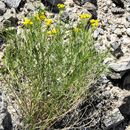Comprehensive Description
(
Inglês
)
fornecido por North American Flora
Haploesthes greggii A. Gray, Mem. Am. Acad. II. 4: 109. 1849
Aplopappus texanus Coult. Contr. U. S. Nat. Herb. 1: 40. 1890.
An undershrub, woody at the base, branched below, 2-4 dm. high; herbaceous stems glabrous, striate, light-green, fastigiately branched; leaves opposite, filiform, 2-5 cm. long, fleshy, with connate enlarged scarious bases; heads paniculate-cymose, numerous, radiate; involucre campanulate, 4 mm. high; bracts 5, overlapping, broadly oval, rounded at the apex, striate; ray-flowers 3-5, the corolla-tube 2.5-3 mm. long, the ligule oval, yellow, 1.5-2 mm. long, 2-3-toothed; disk-corollas 4.5 mm. long, the tube 2 mm. long, the throat funnelform, the lobes lanceolate; achenes sparingly hairy, 1.5 mm. long.
Type locality: Valley near Ciefiega Grande, Coahuila.
Distribution: Kansas and eastern Colorado to Texas, Coahuila, and Chihuahua.
- citação bibliográfica
- Per Axel Rydberg. 1927. (CARDUALES); CARDUACEAE; LIABEAE, NEUROLAENEAE, SENECIONEAE (pars). North American flora. vol 34(4). New York Botanical Garden, New York, NY
Haploesthes greggii
(
Inglês
)
fornecido por wikipedia EN
Haploesthes greggii, common name false broomweed,[2] is a North American species of flowering plants in the family Asteraceae. It grows in northeastern Mexico (Chihuahua, Coahuila and Nuevo León) and in the south-central and southwestern United States (Texas, Oklahoma, New Mexico; also historical reports of the species in Colorado and Kansas but very likely extirpated there).[3][4][5]
The genus name is sometimes spelled Haploësthes, with two dots over the first e to indicate that the o and the e are to be pronounced in separate syllables. This is optional; either spelling is equally acceptable.[3][6]
Haploesthes greggii is a perennial herb or subshrub up to 80 cm (31 in) tall, somewhat succulent. Leaves are very narrow, sometimes thread-like. The plant produces numerous yellow flower heads in flat-topped arrays. Each head has 3–6 ray flowers and 18-100 disc flowers.[3]
- Varieties[1][3]
-
Haploesthes greggii var. greggii
-
Haploesthes greggii var. texana (J.M.Coult.) I.M.Johnst.
References
-
^ a b The Plant List, Haploesthes greggii var. texana (J.M.Coult.) I.M.Johnst.
-
^ USDA, NRCS (n.d.). "Haploesthes greggii". The PLANTS Database (plants.usda.gov). Greensboro, North Carolina: National Plant Data Team. Retrieved 20 July 2015.
-
^ a b c d Flora of North America, Haploësthes A. Gray, 1849.
-
^ Biota of North America Program 2014 county distribution map
-
^ SEINet, Southwestern Biodiversity, Arizona chapter Haploesthes greggii Gray photos, description, distribution map
-
^ International Code of Nomenclature for algae, fungi, and plants (Melbourne Code) section 60.6

- licença
- cc-by-sa-3.0
- direitos autorais
- Wikipedia authors and editors
Haploesthes greggii: Brief Summary
(
Inglês
)
fornecido por wikipedia EN
Haploesthes greggii, common name false broomweed, is a North American species of flowering plants in the family Asteraceae. It grows in northeastern Mexico (Chihuahua, Coahuila and Nuevo León) and in the south-central and southwestern United States (Texas, Oklahoma, New Mexico; also historical reports of the species in Colorado and Kansas but very likely extirpated there).
The genus name is sometimes spelled Haploësthes, with two dots over the first e to indicate that the o and the e are to be pronounced in separate syllables. This is optional; either spelling is equally acceptable.
Haploesthes greggii is a perennial herb or subshrub up to 80 cm (31 in) tall, somewhat succulent. Leaves are very narrow, sometimes thread-like. The plant produces numerous yellow flower heads in flat-topped arrays. Each head has 3–6 ray flowers and 18-100 disc flowers.
Varieties Haploesthes greggii var. greggii Haploesthes greggii var. texana (J.M.Coult.) I.M.Johnst.
- licença
- cc-by-sa-3.0
- direitos autorais
- Wikipedia authors and editors

